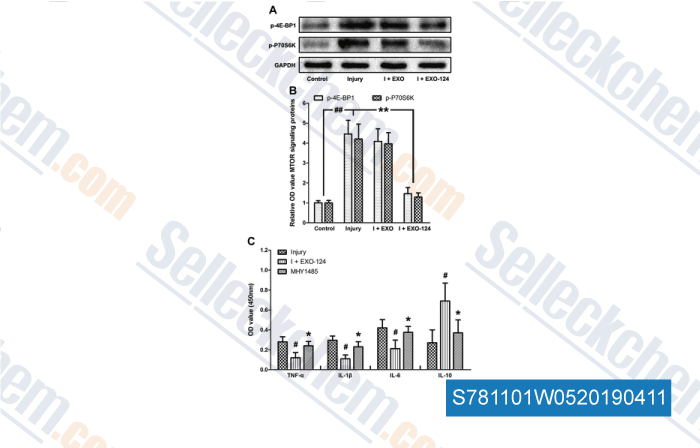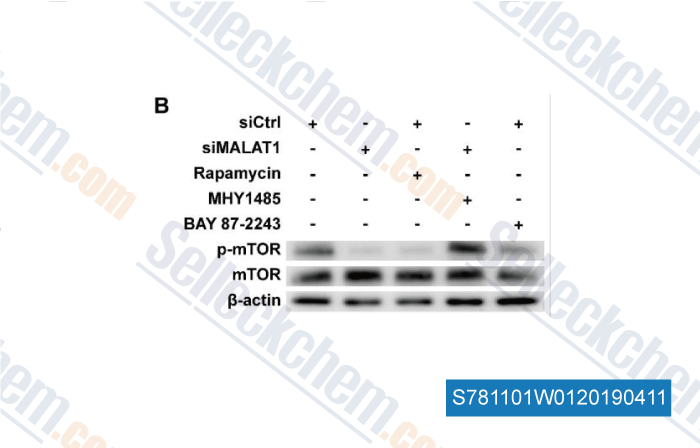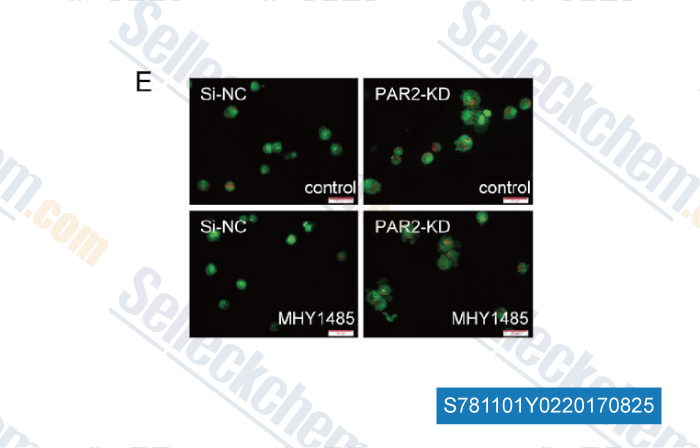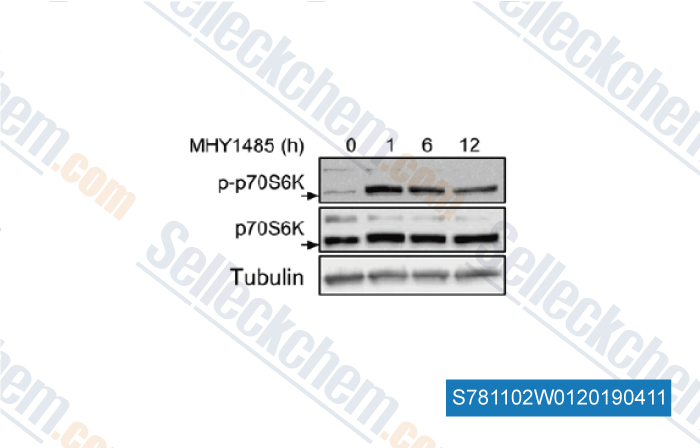|
Toll Free: (877) 796-6397 -- USA and Canada only -- |
Fax: +1-832-582-8590 Orders: +1-832-582-8158 |
Tech Support: +1-832-582-8158 Ext:3 Please provide your Order Number in the email. |
Technical Data
| Formula | C17H21N7O4 |
||||||
| Molecular Weight | 387.39 | CAS No. | 326914-06-1 | ||||
| Solubility (25°C)* | In vitro | DMSO | 3.75 mg/mL (9.68 mM) | ||||
| Water | Insoluble | ||||||
| Ethanol | Insoluble | ||||||
| In vivo (Add solvents to the product individually and in order) |
|
||||||
|
* <1 mg/ml means slightly soluble or insoluble. * Please note that Selleck tests the solubility of all compounds in-house, and the actual solubility may differ slightly from published values. This is normal and is due to slight batch-to-batch variations. * Room temperature shipping (Stability testing shows this product can be shipped without any cooling measures.) |
|||||||
Preparing Stock Solutions
Biological Activity
| Description | MHY1485 is a potent, and cell-permeable mTOR activator, and also potently inhibits autophagy. | |
|---|---|---|
| Targets |
|
|
| In vitro | MHY1485 suppresses the basal autophagic flux. MHY1485 causes the accumulation of LC3II and enlargement of the autophagosomes in a dose- and time- dependent manner.[1] MHY1485 increases phospho-mTOR levels and phosphorylation of downstream S6K1 and rpS6 proteins without affecting total mTOR content, total S6K1 and rpS6 levels. Short-term treatment of ovaries with MHY1485 followed by allo-transplantation promoted secondary follicle growth. Treatment with MHY1485 and subsequent grafting allowed the derivation of mature oocytes and healthy offspring.[2] |
|
| In vivo | MHY1485 is a potent, and cell-permeable mTORC1 agonist. |
Protocol (from reference)
| Kinase Assay: |
|
|---|---|
| Cell Assay: |
|
References
|
Customer Product Validation

-
Data from [ , , FASEB J, 2018, 32(1):512-528 ]

-
Data from [ , , Int J Biol Sci, 2017, 13(11):1398-1408 ]

-
Data from [ , , Biochem J, 2017, 474(16):2733-2747 ]

-
Data from [ , , Oncol Rep, 2018, 40(1):425-433 ]
Selleck's MHY1485 has been cited by 99 publications
| Metformin attenuates alveolar bone destruction in mice with apical periodontitis and inhibits pro-inflammatory cytokine synthesis in lipopolysaccharide-stimulated RAW264.7 through the AMPK-mTOR-NF-κB pathway [ Front Immunol, 2025, 16:1643676] | PubMed: 40821823 |
| Natural polyphenol mangiferin delays neuronal cell senescence by inhibiting neuroinflammation mediated by microglial activation [ IBRO Neurosci Rep, 2025, 18:574-591] | PubMed: 40271493 |
| Targeted knockdown of PGAM5 in synovial macrophages efficiently alleviates osteoarthritis [ Bone Res, 2024, 12(1):15] | PubMed: 38433252 |
| Augmented ERO1α upon mTORC1 activation induces ferroptosis resistance and tumor progression via upregulation of SLC7A11 [ J Exp Clin Cancer Res, 2024, 43(1):112] | PubMed: 38610018 |
| Gestational exposure to PM2.5 disrupts fetal development by suppressing placental trophoblast syncytialization via progranulin/mTOR signaling [ Sci Total Environ, 2024, 921:171101] | PubMed: 38387595 |
| Multi-omics analyses of cancer-linked clinical salmonellae reveal bacterial-induced host metabolic shift and mTOR-dependent cell transformation [ Cell Rep, 2024, 43(11):114931] | PubMed: 39488829 |
| Toosendanin alleviates acute lung injury by reducing pulmonary vascular barrier dysfunction mediated by endoplasmic reticulum stress through mTOR [ Phytomedicine, 2024, 136:156277] | PubMed: 39615214 |
| Tetrahydrocurcumin ameliorates hepatic steatosis by restoring hepatocytes lipophagy through mTORC1-TFEB pathway in nonalcoholic steatohepatitis [ Biomed Pharmacother, 2024, 178:117297] | PubMed: 39137653 |
| Adenosine kinase protects against acetaminophen-induced acute liver injury by activating autophagy in hepatocytes [ Cell Biol Toxicol, 2024, 40(1):59] | PubMed: 39060559 |
| Polyphyllin I alleviates neuroinflammation after cerebral ischemia-reperfusion injury via facilitating autophagy-mediated M2 microglial polarization [ Mol Med, 2024, 30(1):59] | PubMed: 38745316 |
RETURN POLICY
Selleck Chemical’s Unconditional Return Policy ensures a smooth online shopping experience for our customers. If you are in any way unsatisfied with your purchase, you may return any item(s) within 7 days of receiving it. In the event of product quality issues, either protocol related or product related problems, you may return any item(s) within 365 days from the original purchase date. Please follow the instructions below when returning products.
SHIPPING AND STORAGE
Selleck products are transported at room temperature. If you receive the product at room temperature, please rest assured, the Selleck Quality Inspection Department has conducted experiments to verify that the normal temperature placement of one month will not affect the biological activity of powder products. After collecting, please store the product according to the requirements described in the datasheet. Most Selleck products are stable under the recommended conditions.
NOT FOR HUMAN, VETERINARY DIAGNOSTIC OR THERAPEUTIC USE.
